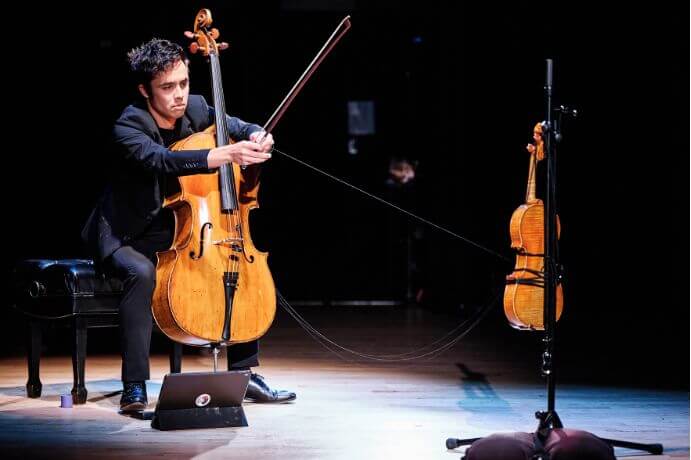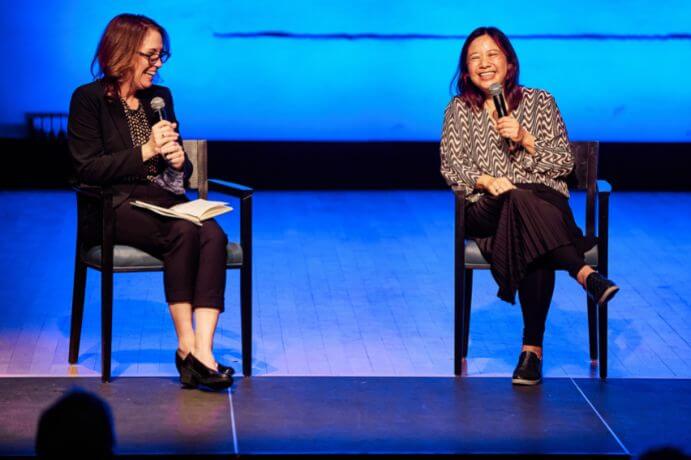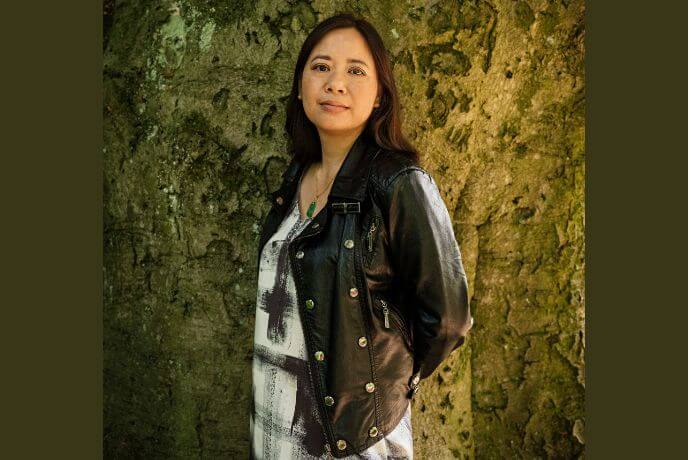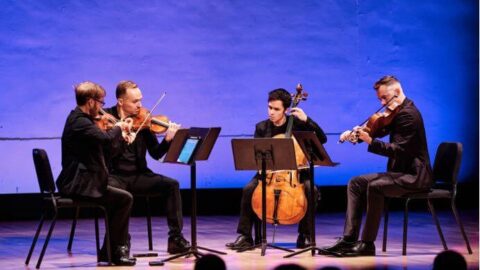The history of rope and string is one of composer Liza Lim’s obsessions. It’s a ubiquitous technology throughout human history, inextricable from our storytelling: we weave themes together; we tangle ourselves up in knots; our nerves fray at the edges. String was the throughline — sometimes literally — at a September 29 concert dedicated to Lim, part of Columbia University’s flagship Composer Portrait series at Miller Theatre.
Featuring a string installation-composition performed by Jay Campbell and the U.S. premiere of a string-themed piece written for the JACK Quartet, the program took a deep dive into core elements of Lim’s artistic motivations and processes. Accompanying the program were Lara Pellegrinelli’s excellent notes on the Australian composer; Pellegrinelli has penned incisive profiles for the concert series since 2018, and her portrait of Lim was as essential as always.
The program opened with an ocean beyond earth (2016), a duo installation for solo cellist. Long parallel cotton strings were tied between corresponding cello and violin strings, which Campbell, the cellist, pulled slowly — one by one — to produce vibrations. Sometimes it seemed as though he conjured the resonant, rasping sound out of thin air; even when the strings were clearly visible, the distance between the cello and violin made it hard to track their movement. It felt magical, but it was dark magic: the violin was bound to a stand like an imprisoned marionette, and the stretched strings were tangled and broken by the end of the piece.

The honeyed amber stage lighting couldn’t erase the eerie sense of unseen powers — perhaps the missing violinist. But as Campbell rotated between epochs of slow-magic string, familiar arco bowing, and sparking pizzicato, the atmosphere slowly ballooned with wonderment. an ocean beyond earth is indeed at the edge of some terrain; the weird and wonderful image of an ocean beyond planet Earth encourages us to tug at new possibilities, if we can endure the tension of the unknown.
This worldbuilding ethos is foundational to Lim’s work, and the composer discussed this with Melissa Smey, the executive director of Miller Theatre, in an onstage conversation between performances. When asked how that foundation relates to her work, Lim said that “artistic practice” is the shared human capacity to tell stories and create passages toward new alternatives. Lim insists that this is not the exclusive domain of artists; it is simply a human characteristic, available to everyone. Perhaps that is one reason she begins String Creatures, the other piece on the program, with our shared feeling of grief.

Lim developed the piece with the JACK Quartet after emerging from the isolation of lockdowns into a fellowship at the Wissenschaftskolleg (Institute for Advanced Study) in Berlin. She asked the quartet to learn string magic tricks; they tied John Pickford Richards’ hands to the neck of his viola and had him wriggle free. The sounds of struggle are foreshadowed in the first movement, “Cat’s Cradle: 3 diagrams of grief,” but the heartrending second movement, “Untethered,” is the sound of fraying nerves: an occasional cello melody struggles toward the surface like a radio station that just won’t lock in, drowning in layers of scratchy, fuzzy sound. And if the psychological landscape was untethered, the physical was the opposite: in one of the most stunning moments, first violinist Christopher Otto grated his bow against the string as though he were tied to his violin, stuck, and aching to escape into one of the soothing melodies that eventually emerged from the mist.
In the final movement, “A nest is woven from the inside out,” Lim made a connection between weaving and ecological concerns. Birds’ nests are not woven in the way we think of looms or needlepoint; rather, they’re constructed somewhat chaotically, from piles of natural fibers that birds collect and then rub their bodies against. The players’ “mechanical movements synthesize in the same way that birds create a coherent structure,” Lim explained. This “sonic nest” opens with a 1960s fiddle technique Lim calls a “chop,” which anchors and vitalizes the shimmering, minimalistic texture. Revved up by the rhythmic chop, the JACK Quartet rubbed and swept their bows across the strings. The increased friction piled up into a gauzy structure that twinkled with a lush cello theme and pokey twigs of chromaticism.

I knew this program would allow me to directly engage with one of today’s most ambitious composers, and the energetic and ripe performances from the JACK Quartet were no surprise; but the delicate and slightly molten catharsis of grief I experienced was a shock. There were warning signs in the concert materials; still, I was unprepared for an experience that was fragile, tenuous, strong, and archaic all at once — which was Lim’s exact description of string.
I CARE IF YOU LISTEN is an editorially-independent program of the American Composers Forum, funded with generous donor and institutional support. Opinions expressed are solely those of the author and may not represent the views of ICIYL or ACF.
A gift to ACF helps support the work of ICIYL. For more on ACF, visit the “At ACF” section or composersforum.org.
























